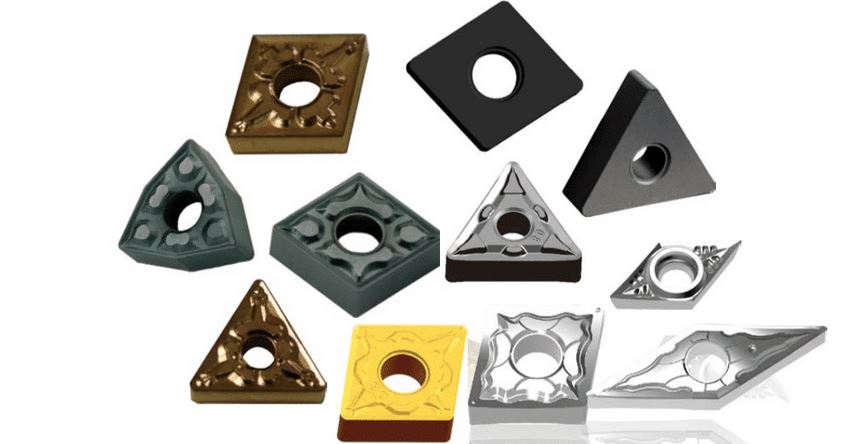超硬チップタングステンカーバイトチップとしても知られる超硬チップは、金属加工と機械加工の世界では重要な部品です。その耐久性、効率性、汎用性から、なくてはならない存在です。機械加工の世界に飛び込もうとしている方、あるいは単に工具をアップグレードしたいと考えている方に、このガイドブックは超硬チップについて知っておくべきことをすべて説明します。超硬チップの種類や用途から、材料特性、適切な超硬チップの選択まで、さっそくご覧ください。
超硬インサートの概要
超硬チップは、製造業や金属加工で広く使用されている切削工具である。炭化物粒子を金属バインダーで結合した複合材料で構成されています。このユニークな組成により、優れた硬度、耐摩耗性、高温耐性が得られ、金属材料の切断、穴あけ、成形に理想的です。
なぜ超硬合金なのか?
- 耐久性がある: 超硬チップは非常に耐久性があり、激しい使用にも耐えることができます。
- 効率が良い: 切れ味と切削効率を長期間にわたって維持する。
- 汎用性がある: 幅広い材料と加工に対応。

種類 超硬インサート
超硬チップには、特定の用途向けに設計された様々な種類があります。ここでは、一般的な種類をご紹介します:
| インサート・タイプ | 説明 |
|---|---|
| シーエヌエムジー | 80°の切れ刃を持つ汎用チップで、荒加工および仕上げ加工に適しています。 |
| DNMG | 仕上げ作業に最適な55°カッティングエッジチップ。 |
| TNMG | 三角形のチップで、荒削りにも仕上げにも多用途。 |
| WNMG | 刃先が80°の三角錐形状で、荒削りや断続切削に使用される。 |
| SNMG | 四角形のインサートで、非常に強く、重作業に使用される。 |
| シーシーエムティー | 80°の切れ刃を持つ片面チップで、旋削加工に使用。 |
| ブイビーエムティー | ダイヤモンド形状のインサート。 |
| アールシーエムティー | プロファイリングとコンタリングに最適なラウンドインサート。 |
| エーピーケーティー | 長方形のチップで、フライス加工に使用されます。 |
| RPGN | 柔らかい素材のプロファイルに最適なラウンドインサート。 |
超硬インサートの用途
超硬チップは、様々な機械加工に使用されています。ここでは、その用途をご紹介します:
| 申し込み | インサート・タイプ | 詳細 |
|---|---|---|
| ターニング | CNMG、DNMG、CCTM、VBMT | 旋盤加工では、固定された切削工具が材料を除去する間、工作物を回転させる。 |
| ミーリング | APKT, RPGN | フライス加工は、回転する切削工具を使用して、さまざまな方向にワークピースから材料を除去する。 |
| 掘削 | WNMG、SNMG | ドリル加工は、回転するドリルビットを使って被加工物に丸い穴を開ける。 |
| つまらない | CNMG、VBMT | ボーリングは、より高い精度を得るために既存の穴を拡大する。 |
| プロファイリング | RCMT、RPGN | プロファイリング加工は、ワークピースに複雑な輪郭や形状を作り出します。 |
| スレッディング | TNMG、VBMT | ねじ切りインサートは、ワークピースにねじ山を切るために使用される。 |
| グルーヴィング | SNMG、CCMT | 溝加工は、被加工物に細い溝を切ることである。 |
| 別れ | SNMG、WNMG | パーティングオペレーションは、ワークピースの一部を切り取る。 |
| フライス加工 | APKT、CCMT | フェースフライス加工は、カッターを使用してワークの表面から材料を除去し、平らな面を作成します。 |
| カッティングの中断 | WNMG、SNMG | 断続切削用に設計されたインサートは、不規則な切削による衝撃や衝撃に耐えることができる。 |
材料特性 超硬インサート
超硬チップの材料特性を理解することは、お客様の用途に適した超硬チップを選択する上で非常に重要です。
| プロパティ | 説明 |
|---|---|
| 硬度 | 超硬チップは非常に硬く、通常モース硬度は8.5~9である。 |
| 耐摩耗性 | 耐摩耗性が高く、切断や研磨用途に最適。 |
| タフネス | その硬さにもかかわらず、衝撃やショックに耐える十分な靭性を持っている。 |
| 耐熱性 | 1000℃を超えるような高温でも硬度と性能を維持できる。 |
| 耐食性 | 耐腐食性に優れ、さまざまな環境下での寿命を延ばす。 |
| 熱伝導率 | 良好な熱伝導性は、切断作業中の放熱に役立つ。 |
| 密度 | 密度が高く、通常14.5~15.0g/cm³である。 |






構成と特徴
超硬合金チップの組成は、その特性と性能に影響する。
| コンポーネント | 説明 |
|---|---|
| 炭化タングステン | 主成分であり、硬度と耐摩耗性をもたらす。 |
| コバルト | バインダーとして働き、強靭性と耐衝撃性を与える。 |
| 炭化チタン | 特に高速切削用途において、硬度と耐熱性を高める。 |
| 炭化タンタル | 特に高温での耐摩耗性と耐変形性を高める。 |
| 炭化ニオブ | 結晶粒組織を改善し、靭性と耐熱衝撃性を高める。 |
硬度、強度、耐摩耗性
これら3つの特性は、特定の用途に対する超硬チップの適合性を決定する上で極めて重要である。
| プロパティ | 説明 |
|---|---|
| 硬度 | ロックウェルスケールまたはビッカーススケールを用いて測定し、材料の変形に対する抵抗力を示す。 |
| 強さ | 材料が破断や変形することなく、機械的応力に耐える能力を示す。 |
| 耐摩耗性 | 切断作業中の摩耗や磨耗に耐える材料の能力を指す。 |
仕様、サイズ、形状、規格
超硬チップには、さまざまな加工ニーズに対応するため、さまざまなサイズ、形状、規格があります。
| 仕様 | 詳細 |
|---|---|
| ISO規格 | ISO 1832:超硬チップの寸法と公差を規定。 |
| シェイプス | 三角形、正方形、菱形、円形、長方形、三角形など。 |
| サイズ | 様々なツールホルダーやアプリケーションに適合するよう、様々なサイズをご用意しています。 |
| グレード | グレードによって硬度、靭性、耐摩耗性が異なる。 |
サプライヤーと価格詳細
信頼できるサプライヤーを見つけ、価格を理解することは、十分な情報を得た上で購入するために極めて重要である。
| サプライヤー | 地域 | 製品範囲 | 価格(概算) |
|---|---|---|---|
| ケナメタル | グローバル | 幅広い超硬チップ | $5~$50(インサートあたり |
| サンドビック・コロマント | グローバル | 高性能インサート | $10~$60(インサートあたり |
| 三菱マテリアル | グローバル | 様々なタイプとグレード | $7~$45(インサートあたり |
| 住友電工 | グローバル | 高度な切削工具 | $8~$55(インサートあたり |
| ISCAR | グローバル | 革新的な超硬チップ | $9~$65(インサートあたり |
| ウォルター・ツールズ | グローバル | 包括的な範囲 | $6~$40(インサートあたり |
| セコ・ツールズ | グローバル | 高精度インサート | $7~$50(インサートあたり |
| YG-1 | グローバル | 手頃な価格の高品質インサート | $5~$35(インサートあたり |
| タンガロイ | グローバル | 先進素材インサート | $10~$55(インサートあたり |
| 京セラ | グローバル | 高耐久性インサート | $8~$50(インサートあたり |
正しい選択 超硬インサート
適切な超硬チップを選ぶには、いくつかの要素を考慮する必要がある。
| 考察 | 詳細 |
|---|---|
| 加工する材料 | 素材が異なれば、必要とされるインサート特性も異なる。 |
| 加工の種類 | 加工の種類(旋盤加工、フライス加工、ドリル加工)によって、必要なチップの形状と特性が決まる。 |
| 切断条件 | 速度、送り速度、切り込み深さは極めて重要な要素である。 |
| ツールホルダー互換性 | インサートが使用するツール・ホルダーに適合していることを確認してください。 |
| コスト | 予算の制約を満たすために、コストとパフォーマンスのバランスをとる。 |
利点と限界
超硬チップの利点と限界を比較することは、十分な情報を得た上での決断に役立つ。
| アスペクト | メリット | 制限事項 |
|---|---|---|
| 硬度 | 非常に硬く、長期間にわたって切れ味が持続する。 | 不適切な使い方をするともろくなり、欠けやすくなる。 |
| 耐摩耗性 | 高い耐摩耗性により、頻繁な交換の必要性を低減。 | 他の素材に比べて高価かもしれない。 |
| 耐熱性 | 高温でも特性を維持し、高速作業に適している。 | 熱による損傷を避けるため、正確な冷却と潤滑が必要。 |
| 汎用性 | 幅広い素材と用途に適している。 | さまざまな用途に特定のインサートが必要なため、在庫の複雑さが増している。 |
| 耐久性 | 長寿命で、ダウンタイムを減らし、生産性を向上させます。 | イニシャルコストが高いことは、ユーザーによっては考慮すべき点かもしれない。 |

よくあるご質問
超硬チップは何に使用されますか?
超硬チップは、旋盤加工、フライス加工、ドリル加工、ボーリング加工など、さまざまな機械加工に使用される。硬度、耐摩耗性、高温下でも性能を維持できることから好まれている。
用途に合った超硬チップの選び方は?
適切な超硬チップを選択するには、加工する材料、加工作業の種類、切削条件、ツールホルダーとの適合性、コストを考慮する必要があります。
超硬チップを使用する利点は何ですか?
主な利点は、高硬度、優れた耐摩耗性、耐熱性、汎用性、耐久性などです。これらの特性は、生産性の向上と工具寿命の延長につながります。
超硬チップは再利用できますか?
はい、超硬チップは、再研磨後に再利用できることがよくあります。しかし、再利用の範囲は、チップの状態と特定の加工要件に依存します。
超硬チップの一般的な材種は?
一般的なグレードにはC2、C3、C5、C7があり、それぞれ特定の用途に適した硬度、靭性、耐摩耗性のレベルが異なる。
超硬チップはどのように保管すればよいですか?
直射日光や湿気を避け、涼しく乾燥した場所に保管する。適切な保存容器を使うことで、傷みを防ぎ、品質を保つことができる。
超硬チップを使用する際に、環境面で考慮すべき点はありますか?
超硬チップは、リサイクル可能な材料から作られています。環境への影響を最小限に抑えるためには、適切なリサイクル方法に従うことが重要です。
超硬チップの一般的なブランドは何ですか?
人気ブランドには、ケナメタル、サンドビック・コロマント、三菱マテリアル、住友電気工業、ISCAR、ウォルター・ツールズ、セコ・ツールズ、YG-1、タンガロイ、京セラなどがある。
超硬チップと他の切削工具との比較は?
他の切削工具に比べ、超硬チップは硬度、耐摩耗性、耐熱性に優れている。耐久性と効率に優れているが、初期コストが高くなる場合がある。
超硬チップの平均寿命は?
寿命は、用途、加工材料、切削条件によって異なる。しかし、超硬チップはその耐久性により、一般的に他の切削工具よりも長持ちする。
結論
超硬チップは、比類のない耐久性、効率性、および汎用性を提供する、現代の機械加工の要です。ベテランのプロフェッショナルであれ、機械加工の世界に足を踏み入れたばかりであれ、超硬チップの種類、用途、材料特性、選択基準を理解することは、生産性と機械加工の成功に大きく影響します。
適切な超硬チップを選択することで、加工作業を強化し、ダウンタイムを削減し、優れた結果を得ることができます。様々な選択肢を検討し、お客様の具体的なニーズを理解し、超硬チップの可能性をプロジェクトで最大限に活用するために、十分な情報を得た上で決定してください。




